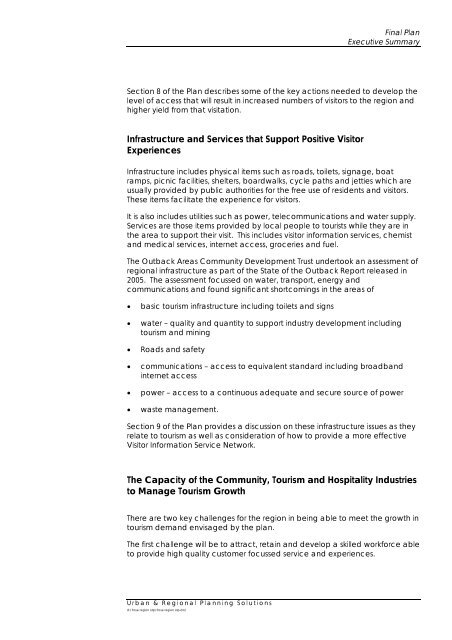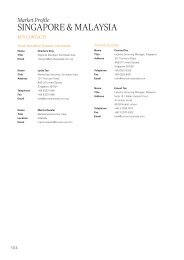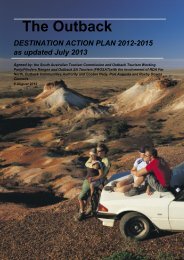Flinders Ranges and Outback Integrated Strategic Tourism Plan
Flinders Ranges and Outback Integrated Strategic Tourism Plan
Flinders Ranges and Outback Integrated Strategic Tourism Plan
You also want an ePaper? Increase the reach of your titles
YUMPU automatically turns print PDFs into web optimized ePapers that Google loves.
Final <strong>Plan</strong><br />
Executive Summary<br />
Section 8 of the <strong>Plan</strong> describes some of the key actions needed to develop the<br />
level of access that will result in increased numbers of visitors to the region <strong>and</strong><br />
higher yield from that visitation.<br />
Infrastructure <strong>and</strong> Services that Support Positive Visitor<br />
Experiences<br />
Infrastructure includes physical items such as roads, toilets, signage, boat<br />
ramps, picnic facilities, shelters, boardwalks, cycle paths <strong>and</strong> jetties which are<br />
usually provided by public authorities for the free use of residents <strong>and</strong> visitors.<br />
These items facilitate the experience for visitors.<br />
It is also includes utilities such as power, telecommunications <strong>and</strong> water supply.<br />
Services are those items provided by local people to tourists while they are in<br />
the area to support their visit. This includes visitor information services, chemist<br />
<strong>and</strong> medical services, internet access, groceries <strong>and</strong> fuel.<br />
The <strong>Outback</strong> Areas Community Development Trust undertook an assessment of<br />
regional infrastructure as part of the State of the <strong>Outback</strong> Report released in<br />
2005. The assessment focussed on water, transport, energy <strong>and</strong><br />
communications <strong>and</strong> found significant shortcomings in the areas of<br />
• basic tourism infrastructure including toilets <strong>and</strong> signs<br />
• water – quality <strong>and</strong> quantity to support industry development including<br />
tourism <strong>and</strong> mining<br />
• Roads <strong>and</strong> safety<br />
• communications – access to equivalent st<strong>and</strong>ard including broadb<strong>and</strong><br />
internet access<br />
• power – access to a continuous adequate <strong>and</strong> secure source of power<br />
• waste management.<br />
Section 9 of the <strong>Plan</strong> provides a discussion on these infrastructure issues as they<br />
relate to tourism as well as consideration of how to provide a more effective<br />
Visitor Information Service Network.<br />
The Capacity of the Community, <strong>Tourism</strong> <strong>and</strong> Hospitality Industries<br />
to Manage <strong>Tourism</strong> Growth<br />
There are two key challenges for the region in being able to meet the growth in<br />
tourism dem<strong>and</strong> envisaged by the plan.<br />
The first challenge will be to attract, retain <strong>and</strong> develop a skilled workforce able<br />
to provide high quality customer focussed service <strong>and</strong> experiences.<br />
Urban & Regional <strong>Plan</strong>ning Solutions<br />
d:\frosa region istp\frosa region istp.doc





